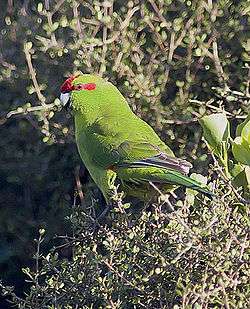Cyanoramphus
| Cyanoramphus | |
|---|---|
 | |
| Red-crowned parakeet (Cyanoramphus novaezelandiae) | |
| Scientific classification | |
| Kingdom: | Animalia |
| Phylum: | Chordata |
| Class: | Aves |
| Order: | Psittaciformes |
| Superfamily: | Psittacoidea |
| Family: | Psittaculidae |
| Subfamily: | Platycercinae |
| Tribe: | Platycercini |
| Genus: | Cyanoramphus Bonaparte, 1854 |
| Species | |
|
Cyanoramphus auriceps | |
Cyanoramphus is a genus of parakeets native to New Zealand and islands of the southern Pacific Ocean. The New Zealand forms are often referred to as kākāriki. They are small to medium-sized parakeets with long tails and predominately green plumage. Most species are forest species, although several of the subantarctic species live in open grassland. The genus formerly had a disjunct distribution, with two species found in the Society Islands and the majority of the genus ranging from New Caledonia to Macquarie Island, but absent from the 4100 km in between. Despite many fossil birds being found in the islands between these two areas being found none of these were of undescribed Cyanoramphus species.[1]
Like many other species of birds the Cyanoramphus parakeets have suffered from changes brought about by humans. The two species from the Society Islands, the black-fronted parakeet and the Society parakeet, have become extinct as have the subspecies from Lord Howe Island and Macquarie Island, as well as an undescribed form from Campbell Island. One species, the Malherbe's parakeet (C. malherbi), is critically endangered while most other species are endangered or vulnerable. Habitat loss and introduced species are considered responsible for the declines and extinctions.[2]
Species
| |||||||||||||||||||||||||||||||||||||||||||||||||||
| Phylogeny of Cyanoramphus |
The list currently accepted of Cyanoramphus taxa, following Boon et al. (2001)[3] is:
- Yellow-crowned parakeet C. auriceps
- Malherbe's parakeet or orange-fronted parakeet C. malherbi
- Red-crowned parakeet C. novaezelandiae
- New Zealand red-crowned parakeet C. novaezelandiae novaezelandiae
- Chatham Island red-crowned parakeet C. novaezelandiae chathamensis
- Kermadec red-crowned parakeet C. novaezelandiae cyanurus
- Lord Howe parakeet C. subflavescens† (formerly considered a subspecies of C. novaezelandiae) (Christidis & Boles, 2008;[4] Hume & Walters, 2012,[5] IOC)
- Chatham parakeet C. forbesi (formerly considered a subspecies of C. auriceps).
- Antipodes parakeet C. unicolor
- Black-fronted parakeet C. zealandicus†
- Macquarie parakeet C. erythrotis † (formerly considered a subspecies of C. novaezelandiae)
- Reischek's parakeet C. hochstetteri (formerly considered a subspecies of C. novaezelandiae).
- New Caledonian parakeet C. saisseti (formerly considered a subspecies of C. novaezelandiae).
- Norfolk parakeet C. cooki (formerly considered a subspecies of C. novaezelandiae).
- Society parakeet C. ulietanus†
The two forms of C. erythrotis are usually considered to be distinct species: the single specimen believed to be from Macquarie Island (Canterbury Museum specimen AV2099, O'Connor catalog 369) in Boon et al.'s analysis has turned out to be from the Antipodes Islands population (hochstetteri) instead.[6] In addition there are subfossil remains from a yet undescribed extinct Cyanonoramphus species from Campbell Island.[7]
References
- ↑ Steadman D, (2006). Extinction and Biogeography in Tropical Pacific Birds, University of Chicago Press. ISBN 978-0-226-77142-7
- ↑ Taylor R (1979) "How the Macquarie Island Parakeet Became Extinct" New Zealand Journal of Ecology 2: 42-45
- ↑ Boon, W.M.; Kearvell, J.; Daugherty, C. H.; Chambers, G. K. (2001): Molecular systematics and conservation of kakariki (Cyanoramphus spp.). Science for Conservation 176
- ↑ Christidis, L. and Boles, W. E. (2008). Systematics and Taxonomy of Australian Birds. CSIRO Publishing Melbourne
- ↑ Michael P. Walters & Julian Pender Hume: Extinct Birds, Poyser Monographes A & C Black, 2012. ISBN 978-140-815-725-1 p 171
- ↑ Scofield, R. Paul (2005): The supposed Macquarie parakeet in the collection of Canterbury Museum. Notornis 52(2): 117-120. PDF fulltext
- ↑ Richard N. Holdaway; Jeanette M. Thorneycroft; Peter McClelland; Michael Bunce: Former presence of a parakeet (Cyanoramphus sp.) on Campbell Island, New Zealand subantarctic, with notes on the island's fossil sites and fossil record. Notornis 57: 8-18. 2010
External links
| Wikimedia Commons has media related to Cyanoramphus. |